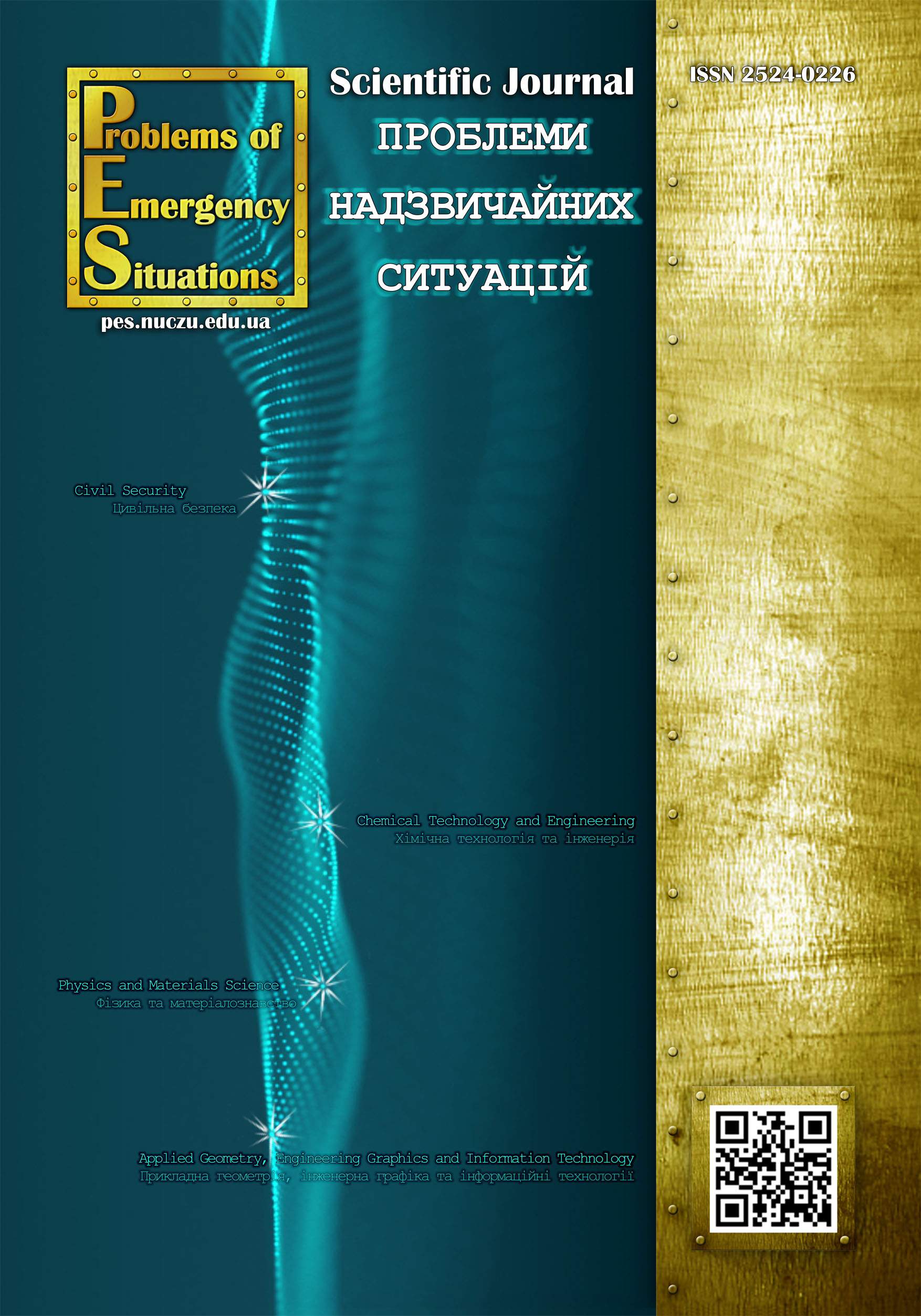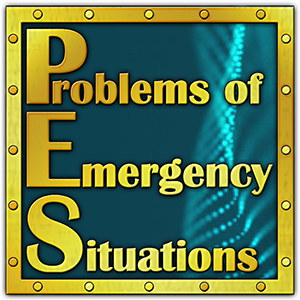Rudakov Serhii
National University of Civil Protection of Ukraine
https://orcid.org/0000-0001-8263-0476
Myrgorod Oksana
National University of Civil Protection of Ukraine
http://orcid.org/0000-0002-5989-3435
Petukhova Olena
National University of Civil Protection of Ukraine
https://orcid.org/0000-0002-4832-1255
Pirohov Oleksandr
National University of Civil Protection of Ukraine
http://orcid.org/0000-0002-0958-0801
Shcholokov Eduard
National University of Civil Protection of Ukraine
https://orcid.org/0000-0002-9923-1487
Korniienko Ruslan
National University of Civil Protection of Ukraine
http://orcid.org/0000-0003-4854-283X
DOI: https://doi.org/10.52363/2524-0226-2024-40-16
Keywords: method of regression analysis, reserve time, complex of means of informing passengers, hypoxia
Аnnotation
The work includes an improved complex of technical means of collective informing about the values of the maximum reserve time of consciousness preservation in emergency situations (ES) of high-altitude flights. Statistical data on the occurrence of emergency situations (ES) on passenger aircraft were studied, which indicate the need to develop means of ensuring the safety of passengers of civil aviation aircraft in the event of emergency situations.One such complex is a complex of technical means of collectively informing passengers about the values of the maximum reserve time of maintaining consciousness in emergency situations in high-altitude flights. The object of the study is the organization of the safety of aircraft passengers in the event of an emergency.The article addressed the problem of ensuring the safety of aircraft passengers by identifying and eliminating some discrepancies between the possibilities of informing passengers and the lack of a set of technical means that allow such information to be implemented.To eliminate such discrepancies, a mathematical approach to the synthesis of integral indicators of the danger of high-altitude flight emergencies was considered, which made it possible to substantiate the need for the development of technologies for monitoring the situation in the aircraft cabin for the timely recognition of potentially dangerous situations caused by a decrease in barometric pressure. The work solves the scientific task of the research, which includes the development of a set of scientifically based technical solutions for informing aircraft passengers in the event of a high-altitude flight emergency.The peculiarities and distinguishing features of the obtained results, thanks to which they allowed to solve the researched problem, was the development of the algorithm of riskometry of the safety of high-altitude flights based on the human factor, with the subsequent implementation in the complex of technical means of ensuring safety. In order to build a complex of technical means of notifying passengers in the emergency of high-altitude flights, passenger safety assessments are given, calculated in real time on the basis of primary indicators available for registration during the entire flight (including in the event of an emergency). The practical application of the obtained results can be used in the aviation field in the event of an emergency.
References
- Bugayko, D., Shevchenko, O. (2020). Indicators of air transport sustainable development. Intellectualization o f Logistics and Supply Chain Management, 4, 6–18.
- Analysis on water content of product gas in onboard oxygen generation system (OBOGS) / Dongsheng J. and oth. (2016). International Conference on Aircraft Utility Systems (AUS): conference paper. IEEE, 340–345. https://doi.org/10.1109/
AUS.2016.7748071 - Balbi, G., Moraglio, M. (2016). A Proposal to hybridise communication and mobility research agendas. In: S. Fari, M. Moraglio, еds. Peripheral flows: A Historical Perspective on Mobilities between Cores and Fringes. Newcastle: Cambridge Scholars Publishing, 10–27.
- Safety Management Manual Doc 9859. (2018). Available at: https://www.
unitingaviation.com/publications/9859/ - Groenenboom, J. (2017). Aircraft health monitoring. The True Value of Aircraft Health Monitoring and Data Management. Proceedings of the 13th Maintenance Cost Conference, 172–179.
- Global Market Forecast. Future Journeys 2013–2020. (2013). AIRBUS S.A.S Blagnac Cedex: Art @ Caractere, 125. Available at: http://www.airbus.com/
company/market/forecast/?elD=damfrontend push@docID=33755 - Rudakov, S., Petuhova, О., Mirgorod, O., Kulakov, О. (2022). Efektivnist tehnihnih zasobiv informuvanna pasaziriv povitpanih suden pri nadzvihanih situasiah. Problemi nadzvihanih situasii. H.: NUSZU, 2(36), 133–146. Available at: http://repositsc.nuczu.edu.ua/handle/123456789/17071
- Adrian, T., Crump, R. K., Vogt, E. (2019). Nonlinearity and flight-to-safety in the risk-return trade-off for stocks and bonds. The Journal of Finance, 74, 4, 1931–1973.
- Executive Agreements Database, Statement Regarding the Supplement with The Denmark and Norway Under The Memorandum of Understanding Concerning the Cooperative Framework For System Development and Demonstration of the Joint Strike Fighter, with Annexes Signed At Washington May 28 and June 20, 2022. Entered Into Force June 20, 2022. doi:10.7910/dvn/dpheue
- Ministère de laménagement du territoire et de lenvironnement (France) / International Handbook on Forest Fire Protection Technical guide for the countries of the Mediterranean basin, 2020, 149.
- L. Fedrizzi, S. Rossi, R. Cristel, P.L. (2020). Borona. Corrosion and behavior of HVOF cermet coating used to replace hard chromium.Electrochim. Acta 2020, 49, 2803–2814.
- Analysis on water content of product gas in onboard oxygen generation system (OBOGS) / Dongsheng J. and oth. (2016). International Conference on Aircraft Utility Systems (AUS): conference paper. IEEE, 340–345. doi: 10.1109/AUS.2016.7748071
- Zarubin, F. (2015). Visotne obladnanna litalnyh aparativ, navs. posidnyk. Harkiv, HNUPS, 112.
- Military Unmanned Systems. Annual Handbook. ISSUE 26. April 2018. Shephard, 368.
- NWCG (National Wildfire Coordinating Group). (2020). Standards for Aerial Supervision, February, 120.
- Zakharin, F., Ponomarenko, S. (2017). Unmanned Aeral Vehicle Integrated Navigation Complex with Adaptive Tuning/Proceedings of IEEE 4 th International Conference, Kyiv, 23–26.
- Grishmanov, E., Mogilatenko,A., Danilov,Yu. (2019). Development of information technology for automated forecasting of adverse aviation events in flight. Control, navigation and communication systems. Collection of scientific papers, 1, 53, 36–40. doi: 10.26906/sunz.2019.1.036














